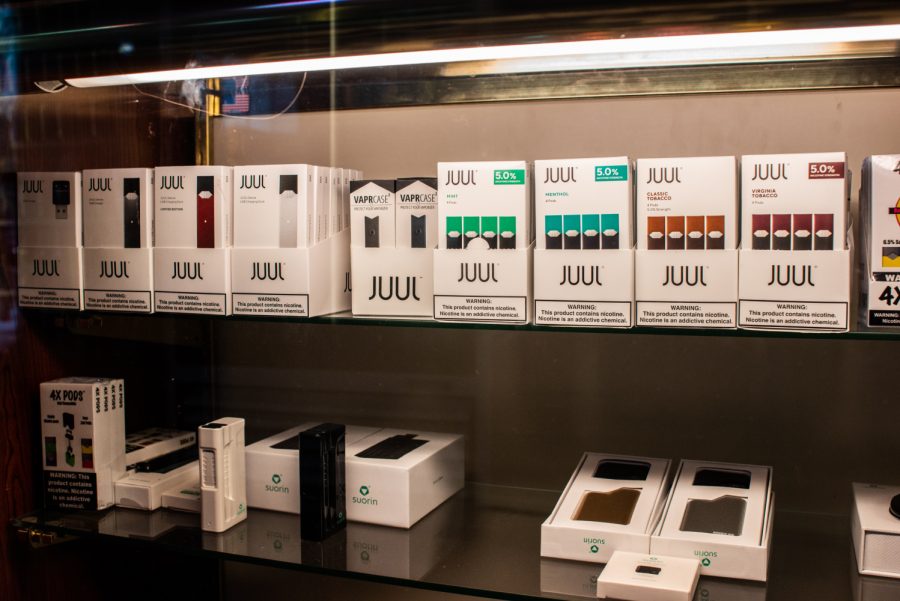In an effort to quit smoking, cigarette users turn to vaping as a solution
A rising trend for smokers trying to quit is to switch to using e-cigarettes, vapes and Juuls because of the ability to control nicotine intake.
A case of e-cigarettes are seen at the Konnexion in Iowa City on Sunday, February 10, 2019.
February 13, 2019
As vaping and Juuling become more popular, some are beginning to use those methods as a means of kicking the habit of smoking.
When Juul came out, it was advertised as a way to quit smoking, said Stephanie Beecher, the University of Iowa Student Health & Wellness senior behavioral health consultant. Juuling has helped some people quit smoking, but according to the FDA, it isn’t a proven method of quitting, she said.
Beginning to use e-cigarettes along with cigarettes may help users reduce their nicotine intake, but they’re then putting two different combinations of chemicals into their bodies, Beecher said. E-cigarettes contain fewer chemicals than cigarettes — which contain 7,000 chemicals — and are considered to be safer, but they’re not necessary safe altogether, she said.
UI Student Health and Wellness previously conducted a study, and found that percentages of students using cigarettes has fallen, while e-cigarette usage is up. In 2012, 34 percent of students reported using cigarettes, and that number has dropped to 31 percent in 2018. 17.5 percent of students used e-cigarettes in 2016, and that number rose to 34.4 percent in 2018.
“We know that nicotine is in [e-cigarettes], we know that metal is in there, and again the FDA doesn’t have regulations on it at the moment, so right now we really don’t know 100 percent what’s in them,” Beecher said.
A pod or a cartridge for an e-cigarette is equivalent to a pack of cigarettes, Beecher said. This makes it difficult for users to track how much nicotine is getting into their bodies when they vape. Juul pods and vaping cartridges have different dosages of nicotine available, allowing users to control how much nicotine is in the device. It is also more difficult to begin weaning off e-cigarettes without knowing how much nicotine a user is getting, she said.
With cigarettes, there are medications, patches, and gum available to help users quit smoking. With e-cigarettes, it’s unclear what is the most effective way to quit, Beecher said. The way she suggests to help students quit using e-cigarettes is to delay gratification. Holding off from smoking for short periods of time and then gradually increasing that time will help people begin to quit, she said.
RELATED: UI tobacco ban difficult to enforce as students continue to smoke on campus
Alejandra Escoto, a graduate student in the College of Public Health, works with Student Health to develop a “toolkit” with methods to prevent e-cigarette use and assist current users quit smoking, she said in an email to The Daily Iowan.
Through her work, Student Health will be able to implement a campus-wide e-cigarette health campaign, Escoto said. Student Health is working to get student feedback for the campaign, she said.
To make sure the campaign is successful with students, Student Health is conducting focus groups for vape users and non-users, Escoto said.
“The focus groups aren’t meant to ‘call out’ vapers or non-vapers, and, instead, they are designed to be a place where all perspectives can be heard,” Escoto said. “After all, the different perspectives will have the most impact in the process of developing campaign messages and cessation practices.”
When making the decision to quit smoking, UI student Ryan Kowalsky chose to start vaping because he can control the amount of nicotine, he said. Nicotine patches and gum have a set amount in them, and with vaping, a person can control the percentage of nicotine in the device, he said.
Since beginning to vape a couple of months, he now smokes less than half a pack of cigarettes a day and spends less on cigarettes than in the past, Kowalsky said.
It would be interesting to see if vaping is helping other people as well through the use of focus groups, Kowalsky said.
“[Vaping] works when it’s snowing or when it’s really cold most of the time, but not all of the time,” Kowalsky said. “I would say I’ve cut back, but not completely [quit].”






















